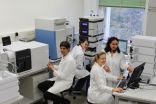Super stable garnet ceramics may be ideal for high-energy lithium batteries
2014-10-21
(Press-News.org) OAK RIDGE, Tenn., Oct. 21, 2014—Scientists at the Department of Energy's Oak Ridge National Laboratory have discovered exceptional properties in a garnet material that could enable development of higher-energy battery designs.
The ORNL-led team used scanning transmission electron microscopy to take an atomic-level look at a cubic garnet material called LLZO. The researchers found the material to be highly stable in a range of aqueous environments, making the compound a promising component in new battery configurations.
Researchers frequently seek to improve a battery's energy density by using a pure lithium anode, which offers the highest known theoretical capacity, and an aqueous electrolyte that can speedily transport lithium. The ORNL scientists believe the LLZO would be an ideal separator material, which is crucial.
"Many novel batteries adopt these two features [lithium anode and aqueous electrolyte], but if you integrate both into a single battery, a problem arises because the water is very reactive when in direct contact with lithium metal," said ORNL postdoctoral associate Cheng Ma, first author on the team's study published in Angewandte Chemie. "The reaction is very violent, which is why you need a protective layer around the lithium."
Battery designers can use a solid electrolyte separator to shield the lithium, but their options are limited. Even the primary separator of choice, known as LAPT or LISICON, tends to break down under normal battery operating conditions.
"Researchers have searched for a suitable solid electrolyte separator material for years," said ORNL's Miaofang Chi, the study's lead author. "The requirements for this type of material are very strict. It must be compatible with the lithium anode because lithium is reactive, and it also has to be stable over a wide pH range, because you can have an alkaline environment -- especially with lithium air batteries."
The researchers used atomic resolution imaging to monitor structural changes in LLZO after the samples' immersion in a range of aqueous solutions. The team's observations showed that the compound remained structurally stable over time across neutral and extremely alkaline environments.
"This solid electrolyte separator remains stable even for a pH value higher than 14," Ma said. "It gives battery designers more options for the selection of aqueous solutions and the catholyte." Catholyte is the portion of the electrolyte close to the cathode.
In lithium-air batteries, for instance, researchers have previously tried to avoid the degradation of the separator by diluting the aqueous solutions, which only makes the battery heavier and bulkier. With this new type of solid electrolyte separator, there is no need to dilute the aqueous electrolyte, so it indirectly increases the battery's energy density.
Higher-energy batteries are in demand for electrified transportation and electric grid energy storage applications, leading researchers to explore battery designs beyond the limits of lithium-ion technologies.
The researchers intend to continue their research by evaluating the LLZO garnet's performance in an operating battery. Coauthors are ORNL's Chengdu Liang, Karren More, Ezhiylmurugan Rangasamy, and Michigan State University's Jeffrey Sakamoto. The study is published as "Excellent Stability of a Li-Ion-Conducting Solid Electrolyte upon Reversible Li+/H+ Exchange in Aqueous Solutions."
INFORMATION:
This research was conducted in part at the Center for Nanophase Materials Sciences, a DOE Office of Science User Facility. The research was supported by DOE's Office of Science.
UT-Battelle manages ORNL for the Department of Energy's Office of Science. The Office of Science is the single largest supporter of basic research in the physical sciences in the United States, and is working to address some of the most pressing challenges of our time. For more information, please visit http://science.energy.gov/.
Image: : http://www.ornl.gov/Image%20Library/Main%20Nav/ORNL/News/News%20Releases/2014/LLZO-highres.jpg?code=a4ca1053-418e-4def-a23e-3a28a4f81694
Caption: ORNL researchers used scanning transmission electron microscopy to take an atomic-level look at a cubic garnet material called LLZO that could help enable higher-energy battery designs.
NOTE TO EDITORS: You may read other press releases from Oak Ridge National Laboratory or learn more about the lab at http://www.ornl.gov/news. Additional information about ORNL is available at the sites below:
Twitter - http://twitter.com/ornl
RSS Feeds - http://www.ornl.gov/ornlhome/rss_feeds.shtml
Flickr - http://www.flickr.com/photos/oakridgelab
YouTube - http://www.youtube.com/user/OakRidgeNationalLab
LinkedIn - http://www.linkedin.com/companies/oak-ridge-national-laboratory
Facebook - http://www.facebook.com/Oak.Ridge.National.Laboratory
[Attachments] See images for this press release:

ELSE PRESS RELEASES FROM THIS DATE:
2014-10-21
Boulder, CO, USA — Washington's coast is so close to the seismically active Cascadia Subduction Zone that if a megathrust earthquake were to occur, a tsunami would hit the Washington shoreline in just 25 minutes.
One coastal community is preparing for such a disaster by starting construction on the nation's first tsunami evacuation refuge, large enough to shelter more than 1,000 people who are within 20-minute walking distance.
The vertical evacuation-refuge will be the roof of the gym of the new school in Grays Harbor County, Washington. The Ocosta Elementary ...
2014-10-21
They may be tiny and stingless but there's nothing sweet and innocent about a species of native Sugarbag bee when it goes to war over a coveted honey-filled hive.
A study by behavioural ecologist Dr Paul Cunningham, from QUT, and molecular biologist Dr James Hereward, from the University of Queensland, published in American Naturalist, found the bees' used their jaws as lethal weapons when they zoomed in on a neighbouring Brisbane hive to boot out the inhabitants and install their own queen to rule.
Dr Cunningham said the attacking bees arrived in a swarm and clashed ...
2014-10-21
This news release is available in German. Stroma cells are derived from connective tissue and may critically influence tumour growth. This knowledge is not new. However, bioanalyst Christopher Gerner and an interdisciplinary team from the University of Vienna and the Medical University of Vienna have developed a novel methodology for investigation. Using modern mass spectrometry, tumour-promoting activities from breast fibroblasts were directly determined from needle biopsy samples. Recently this experimental break-through is published in the renowned Journal of Proteome ...
2014-10-21
Folsom, Calif., (October 21, 2014) – A new animal study published in the Journal of Alzheimer's Disease indicates that a diet including walnuts may have a beneficial effect in reducing the risk, delaying the onset, slowing the progression of, or preventing Alzheimer's disease.
Research led by Abha Chauhan, PhD, head of the Developmental Neuroscience Laboratory at the New York State Institute for Basic Research in Developmental Disabilities (IBR), found significant improvement in learning skills, memory, reducing anxiety, and motor development in mice fed a walnut-enriched ...
2014-10-21
When it comes to the brain, "more is better" seems like an obvious assumption. But in the case of synapses, which are the connections between brain cells, too many or too few can both disrupt brain function.
Researchers from Princeton University and the University of California-San Diego (UCSD) recently found that an immune-system protein called MHCI, or major histocompatibility complex class I, moonlights in the nervous system to help regulate the number of synapses, which transmit chemical and electrical signals between neurons. The researchers report in the Journal ...
2014-10-21
Massive black holes spewing out radio-frequency-emitting particles at near-light speed can block formation of new stars in aging galaxies, a study has found.
The research provides crucial new evidence that it is these jets of "radio-frequency feedback" streaming from mature galaxies' central black holes that prevent hot free gas from cooling and collapsing into baby stars.
"When you look into the past history of the universe, you see these galaxies building stars," said Tobias Marriage, assistant professor of physics and astronomy at Johns Hopkins and co-lead author ...
2014-10-21
A new medical imaging method being developed at Rutgers University could help physicians detect cancer and other diseases earlier than before, speeding treatment and reducing the need for invasive, time-consuming biopsies.
The potentially lifesaving technique uses nanotechnology to reveal small cancerous tumors and cardiovascular lesions deep inside the body. It is showing promise in early tests by Rutgers researchers in the schools of engineering and pharmacy.
The Rutgers scientists, who published initial results of their work in the July issue of the journal Nature ...
2014-10-21
Undescended testis is commonly found in newborn boys and usually normalizes spontaneously by the age of six months. In one in a hundred boys, however, at least one testis remains undescended—a condition associated with impaired fertility and a higher risk of testicular cancer in later life. About 3500 boys are affected with this condition in Germany each year. In the currently valid medical guideline for the treatment of undescended testis, early surgery is recommended, i.e., orchidopexy before the child's first birthday, in order to prevent late sequelae. Nonetheless, ...
2014-10-21
LAWRENCE — Whiplash the Cowboy Monkey. Grumpy Cat. "Peanut," the Ugliest Dog in the World. These might be a sampling of the most familiar animals to millions of users of social networking sites like Facebook.
But one doctoral student in geography at the University of Kansas recognizes social networking sites as a potential boon for scientifically documenting Earth's biodiversity, particularly in developing nations. In fact, for this idea, Vijay Barve was just honored with a Young Researchers Award from the Global Biodiversity Information Facility, an international ...
2014-10-21
CAMBRIDGE, Mass--The boom in oil and gas produced through hydraulic fracturing, or fracking, is seen as a boon for meeting U.S. energy needs. But one byproduct of the process is millions of gallons of water that's much saltier than seawater, after leaching salts from rocks deep below the surface.
Now researchers at MIT and in Saudi Arabia say they have found an economical solution for removing the salt from this water. The new analysis appears this week in the journal Applied Energy, in a paper co-authored by MIT professor John Lienhard, postdoc Ronan McGovern, and four ...
LAST 30 PRESS RELEASES:
[Press-News.org] Super stable garnet ceramics may be ideal for high-energy lithium batteries



